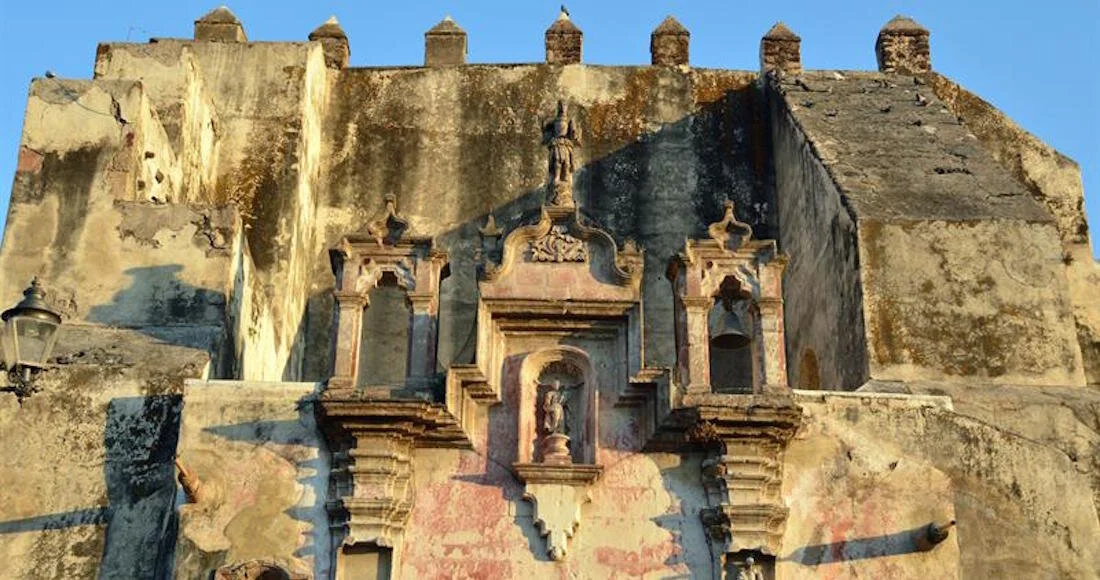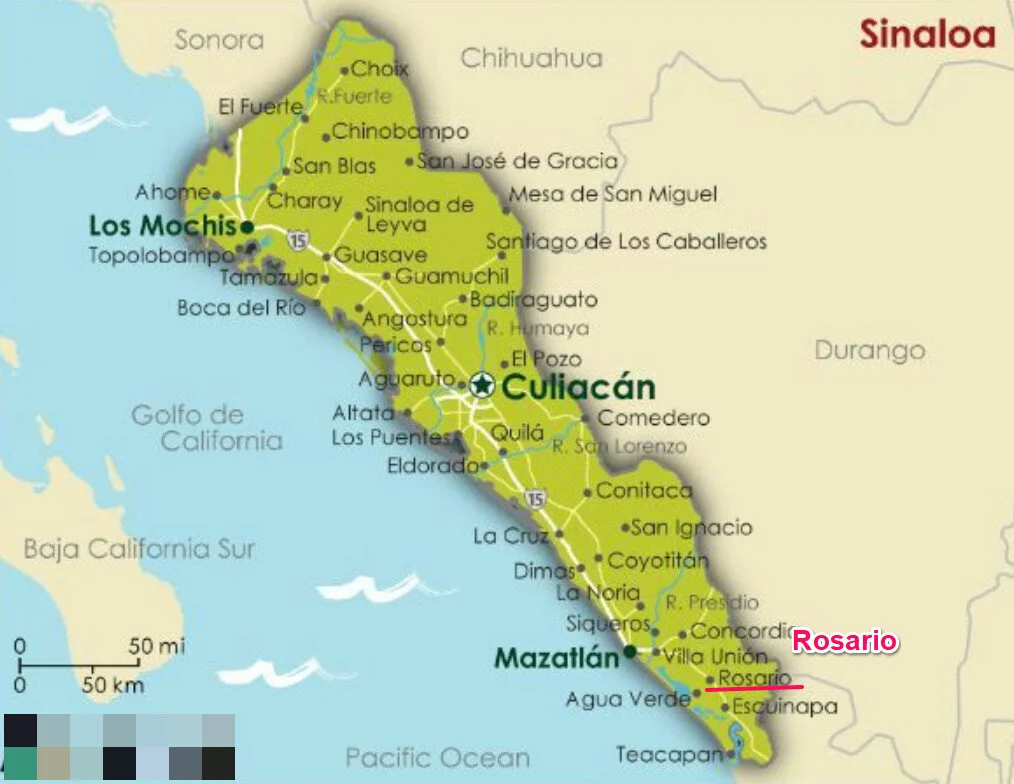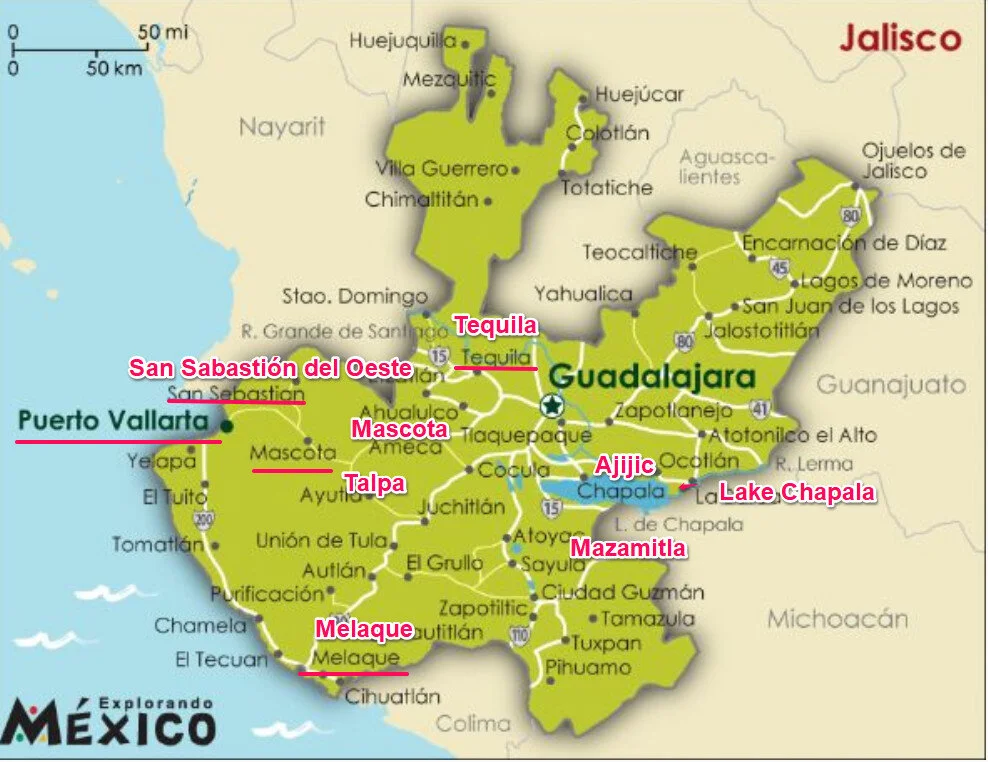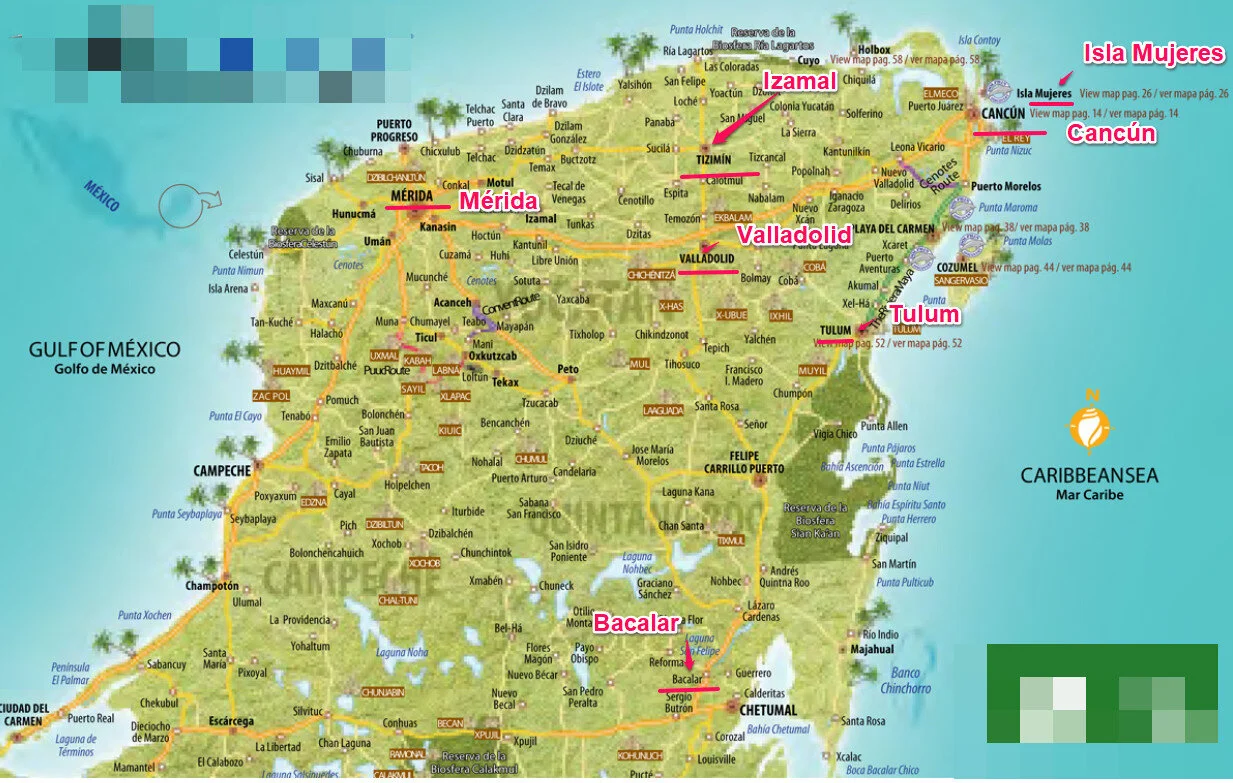Day Trips from Cities in Mexico Most Popular with Expats
Yuriria, in the state of Guanajuato
Day trips from Mexico’s most popular expat cities
No matter how much we love where we live, most of us still like to get out of town from time to time. If you’re like most foreigners living in Mexico, you’ll want to take occasional side trips in Mexico too. The maps on this blog will give you an idea of where these day trips are in relation to the cities most inhabited by expats and American/Canadians who have made Mexico their permanent home.
Pueblo Mágicos in Mexico are places that have been awarded a special designation by the Mexican government for architecture, historical, or ecological significance. They are perfect day trip destinations for the part-time or full time resident. All of the most popular places to live for Canadian and American residents (San Miguel de Allende, Mérida, Mazatán, Lake Chapala, and Puerto Vallarta for example) are within a few hours drive of at least a few of these Pueblos Mágicos.
To give you an idea of the excursions that might be open to you if you lived in Mexico, here is a list of the best Pueblos Mágicos out of the total of 121 in relation to the nearest town popular to expats, Pueblo Magicos that you could reach in less than three hours by car. Bus tours are available from those cities and a popular option even with those who own cars in Mexico.
Sinaloa (The state in which Mazatlán is located)
Pueblos Magicos within the state of Sinaloa
As it’s my city, I am rather biased. Mazatlán is so much more than a beach town. As a working Mexican town (its key industry is fishing), Mazatlán retains its Mexican culture. The jewel of the city is the Angela Peralta theatre in El Centro that provides a rich offering of concerts, ballets, and plays.
Day Trips from Mazatlán
The Pueblos Magicos closest to Mazatlán are Cosalá (in the mountains 2 ½ hours north of Mazatlán), and El Rosario (40 miles southeast of Mazatlán). Cosalá’s nearby dam, López Portilla, is the place for fishing and water sports. The city’s history is tied to 15th century cowboy and marksman Heraclio Bernal who, after being wrongly accused of a robbery, decided to become a thief, one that stole from the rich and gave to the poor. His fame inspired revolutionary Pancho Villa. When In Cósala, look for famous sweets (dulces de leche).
A cowboy features as cental in the history of the other Pueblo Magico close to Mazatlan, El Rosario, where Bonifacio Rojas discovered gold in the town as a result of a campfire he built while in search of a lost cow. The town’s subsequent mining era gave it resources to build some beautiful structures, particularly La Iglesia de Nuestra Señora del Rosario, which you must see for its magnificent gold retablo.
Jalisco (The state in which Lake Chapala, Ajijic and Puerto Vallarta are located)
Above: Here are the pueblo magicos within the state of Jalisco. Some are closer to Guadalajara, others closer to Puerto Vallarta.
Day trips from Puerto Vallarta, Guadalajara in the State of Jalisco
Talpa de Allende is a Spanish silver mining town tucked away in pine forests of the Sierra Madre mountains about 2 ½ hours east of Puerto Vallarta. Talpa de Allende ’s maple tree forest, Bosque de Maple (Talpa means “over the earth), is the largest in Latin America. The town’s plazas, chapels, and maple tree forest create a quiet getaway from the busyness of Puerto Vallarta. Candy shops specialize in every kind of sweet made from the guayaba as well as other fruits.
On the way to Talpa de Allende, you can pass through Mascota, a quaint town offering fresh mountain air, an archeological museum and a lagoon with surrounding spas. The lagoon is believed to be the crater of a volcano, El Molcajete, and is served by a subterranean current. There you can kayak, sail, or fish. Although not a Pueblo Magico, the community of Melaque, made up of two beachfront communities between Manzanilla and Puerto Vallarta (almost four hours by car from Puerto Vallarta), has recently become popular among Canadian retirees.
San Sebastián del Oeste, an hour and a half from Puerto Vallarta, is another mining town (6,000 people) in the Sierra Madres Occidental and a place where time seems to have stopped. Architectural aficionados are drawn to the Iglesia de San Sebastián and the ancient haciendas such as Esperanza de la Galera y Jalisco. Outdoor enthusiasts driving there can enjoy mountain activities such as biking and hiking. The restaurant Jardín Nebulosa in San Sabastián offers locally-sourced dishes (including a soup made with peyote infusion). The local beer to drink is Maximilliana and the bar to drink it in is the popular and often crowded Garitón.
Not far from San Sebastián del Oeste, after passing through the tiny town of Los Reyes, you can drive a dirt road to an enormous cave entrance made out of basaltic prisms. Another choice in the area would be Jardín Haráveri, a recently-opened and amazing botanical garden in La Estancia.
Several other Pueblo Magicos within the sprawling, irregularly-shaped state of Jalisco (which is shaped more like a U.S. gerrymandered voting district than a state) are closer to Guadalajara than Puerto Vallarta.
I have never met a Mexican that didn’t love Guadalajara and I have seen an uptick in inquiries from potential expats looking for life in a large city. Unlike smaller expat destinations, expats are scattered out among the 6-8 nicest neighborhoods of this sprawling city of over four million people that I too love. On the outskirts of Guadalajara is Tlaquepaque, not a Pueblo Magico but definitely worth a day trip.
Day trips from Guadalajara (The state in which San Miguel de Allende and the City of Guanajuato are located)
Lake Chapala, home to Mexico’s largest freshwater lake and only 1 ½ hours away from Guadalajara (close enough is close enough to share resources like the English-language newspaper The Guadalajara Reporter). Lake Chapala has a large well-defined expat community, a majority of which are snowbirds.
Ajijic, almost always mentioned in the same breath as Lake Chapala, is a small pueblo 30 minutes down the road. Ajific is a pure example of a typical mexican pueblo, with wide cobblestone streets, central plaza, and 450 years of history. It’s a place to shop for jewelry, clothing, art, and dine in high profile restaurants serving cuisine from all over the world.
Mazamitla is a place for nature lovers about two hours south of Guadalajara (5 ½ hours from Puerto Vallarta) and has the best landscape views in the North American Cordillera, a mountain range in the Sierra del Tigre and a spot for mountain biking, hiking, rappelling, ATV’s and zip lines. It’s name is Aztec for “place where one hunts deer with arrows.” Mazamitla also has rich local gastronomy; stews, gorditas, and molés. El Salto Lake is world-famous among anglers for its bass fishing.
Tequila is where in October of 1600, Pedro Sánchez de Tagle created the first agave distillery for tequila (and the world would never be the same). You can go to tastings from several distilleries and there’s a nice infrastructure of parks and streets to amble around.
Tapalpa, a little more than a mile above sea level, offers an escape from the big city and the rich smell of pine trees, flowers, and the oak trees that make it the place to find handmade wood furniture. Tapalpa is a little over two hours from Guadalajara via the autopista.
Guanajuato (The state in which San Miguel de Allende and City of Guanajuato are located)
Above: Pueblos Magicos within the state of Guanajuato
Day trips from San Miguel de Allende, in the State of Guanajuato
Itself a Pueblo Magico, San Miguel de Allende was once a Conde Nast “Best City in the World,” and has been expat destinations/art enclave since the end of WWII, when G.I.s came to the city to attend a U.S. accredited art school there on the G.I. bill. San Miguel today has such a large expat population that it has been called “Mexico Light”.
Seven Pueblos Magicos are located in the state of Guanajuato. The colorful capital city of Guanajuato is attracting a growing number of expats and known for narrow alleys, architecture and food. Dolores de Hidalgo, the cradle of Mexican independence, would be the place to explore Mexican history and colonial Baroque architecture. Yuriria, about two hours from San Miguel de Allende, was founded by friars and contains the massive cathedral Templo y Ex Convento de San Agustín that put the town on the map.
Near the cathedral, you can dine at the popular and aptly named restaurant El Monesterio. Lake Yuriria (Lago de Yuriria) and Crater Lake (Lago de Cráter). The lakes, located on a migratory path, provides a winter home for hundreds of types of birds. Bulrush from the lakes are used to create woven baskets and mats to be found in the town’s artesanal stores.
Jalpa de Cánovas, an undiscovered gem, are the grounds of an abundant hacienda famous in the15th and 16th centuries, and provide peaceful haven for those who come there. As the town is about 3 hours from San Miguel de Allende, you could stay in León for a night, where there is a major zoo, a cathedral and catacombs, and a museum of art and history to visit.
Another Pueblo Magico nearby is Mineral de Pozos, a ghost-town-like pueblo of mysterious traditions where several Mexican movies have been filmed (about hour from San Miguel de Allende). Lesser known Pueblos Magicos are the prehispanic towns of Comonfort (Chamacuero de Comonfort) also in the state of Guanajuato is less than an hour from San Miguel de Allende and Salvatierra (less than two hours from San Miguel)
Yucatân Peninsula (The state in which Mérida, Cancún and Tulum are located)
Popular cities for expats in the Yucatán Peninsula
The eastern coast of Mexico has significant expat communities within Mérida (on the western side), Tulum (itself is a Pueblo Magico), Cancún, and Playa Carmen (furthest north) on the eastern side.
Day trips within the Yucatán Peninsula.
Izamál, a little pueblo painted almost totally in yellow about an hour from Mérida is a combination of colonial and Mayan religious influences and a place to buy hammocks, furniture, and ceramics. At El Mercado you can try regional stews (guisos) and regional desserts. Izamál also presents “La Luz de los Mayas” (The Light of the Mayans), a splendid audio light show conveying the mysticism and history of the Mayan culture. Valladolid, almost exactly midway between Cancún and Mérida, while small is perhaps the best jump off point to the most famous of the Yucatan ruins; Chichén Itzá, Ek Balam, and Cobá.
Day trips in the adjacent state of Quintana Roo
Isla Mujeres - An island to the north of Cancún that is a haven for diving and snorkeling a bit more tranquil than Cozmél and a bit easier to get to. It’s a protected breeding ground for the giant tortoise (Granja de Tortugas). The Museo Subacuático de Arte, located near Isla Mujeres and the coast of Punta Nizuc in Cancún, is an underwater museum of 500 permanent life-size sculptures created by Jason deCaires Taylor and part of a movement of fishermen in defense of the sea.
Tulúm (two hours from Cancún, three hours from Mérida) in the Mexican state of Quintana Roo is already an obligatory trip as it a situated around the famous archeological zone of Mayan ruins (Tulum and Cobá) and abuts against Playa Paraíso, one of the most beautiful and photographed beaches of the Riviera Maya.
Tulum is the doorway to a Biological Reserve (Reserva de la Biósfera Sian Ka’an), an ecosystem. For adventurers, Aktun Chen Park contains caverns, tropical jungles, and subterranean rivers. Another options are three cenotes or a nearby barrier reef for diving excursions.
Bacalar, known for its “lagoon of seven colors,” for the colors reflected as a result of the bright sunlight and varying depth of the lagoon that is its principal attraction.
The town, surrounded by lush jungle, is 2 ½ hours south of Tulum. The setting has been compared to the French Polynesian island of Bora Bora for having bungalows and cabanas constructed over the waters rather than luxurious hotel complexes. During a day off from diving, snorkeling, swimming and kayaking, you can visit a fort built against pirate attacks, its grounds converted into gardens and the Museum of Piracy (Museo de la Piratería)
Mexico, of course, is a huge country. People who have traveled for years throughout Mexico marvel how it would be impossible to cover every place worth visiting in a lifetime. These will get you started on the ones close to your new “home” if you ever realize life in Mexico.
Up Next:
You cannot full love a country until you love its music.
Most recent:
How to take Uber in Mexico
About the author:
Kerry Baker is the author of books for people considering life in Mexico, whether full time or a “mini life”.
If Only I Had a Place is the absolute guide to renting in Mexico - far different than you’d think. Don’t be fooled by realtors. The Mexico Solution: Saving you money, sanity, and quality of life through part-time life in Mexico, tells you how to set up for part-time life and the cultural surprises you will encounter along the way. Her most recent work, The Lazy Expat: Healthy Recipes That Translate in Mexico is a cookbook for travelers, snowbirds and expats. In Mexico, you must cook to maintain a healthy diet. This book shows you how.
.





